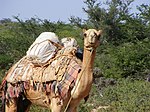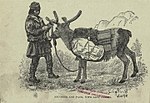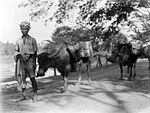
A sled, skid, sledge, or sleigh is a land vehicle that slides across a surface, usually of ice or snow. It is built with either a smooth underside or a separate body supported by two or more smooth, relatively narrow, longitudinal runners similar in principle to skis. This reduces the amount of friction, which helps to carry heavy loads.
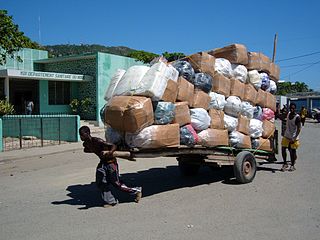
A cart or dray is a vehicle designed for transport, using two wheels and normally pulled by one or a pair of draught animals. A handcart is pulled or pushed by one or more people.

A sled dog is a dog trained and used to pull a land vehicle in harness, most commonly a sled over snow.

A travois is an A-frame structure that was used to drag loads over land, most notably by the Plains Indians of North America.

Surra is a disease of vertebrate animals. The disease is caused by protozoan trypanosomes, specifically Trypanosoma evansi, of several species which infect the blood of the vertebrate host, causing fever, weakness, and lethargy which lead to weight loss and anemia. In some animals the disease is fatal unless treated.

Military animals are trained animals that are used in warfare and other combat related activities. As working animals, different military animals serve different functions. Horses, elephants, camels, and other animals have been used for both transportation and mounted attack. Pigeons were used for communication and photographic espionage. Many other animals have been reportedly used in various specialized military functions, including rats and pigs. Dogs have long been employed in a wide variety of military purposes, more recently focusing on guarding and bomb detection, and along with dolphins and sea lions are in active use today.
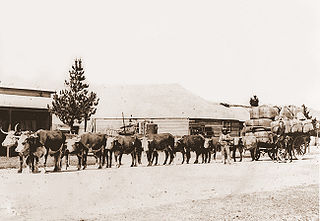
A working animal is an animal, usually domesticated, that is kept by humans and trained to perform tasks instead of being slaughtered to harvest animal products. Some are used for their physical strength or for transportation, while others are service animals trained to execute certain specialized tasks. They may also be used for milking or herding. Some, at the end of their working lives, may also be used for meat or leather.

A horse-drawn vehicle is a piece of equipment pulled by one or more horses. These vehicles typically have two or four wheels and were used to carry passengers or a load. They were once common worldwide, but they have mostly been replaced by automobiles and other forms of self-propelled transport but are still in use today.
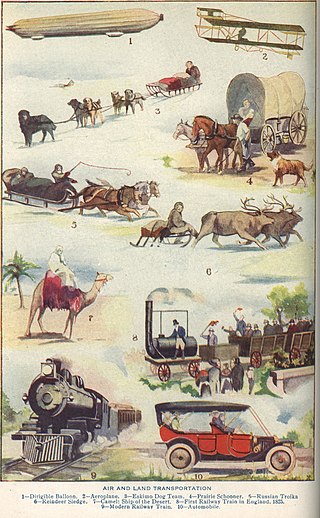
The following outline is provided as an overview of and topical guide to transport:

A pack saddle is any device designed to be secured on the back of a horse, mule, or other working animal so it can carry heavy loads such as luggage, firewood, small cannons, or other things too heavy to be carried by humans.

A packhorse, pack horse, or sumpter refers to a horse, mule, donkey, or pony used to carry goods on its back, usually in sidebags or panniers. Typically packhorses are used to cross difficult terrain, where the absence of roads prevents the use of wheeled vehicles. Use of packhorses dates from the neolithic period to the present day. Today, westernized nations primarily use packhorses for recreational pursuits, but they are still an important part of everyday transportation of goods throughout much of the developing world and have some military uses in rugged regions.

Animal fibers are natural fibers that consist largely of certain proteins. Examples include silk, hair/fur and feathers. The animal fibers used most commonly both in the manufacturing world as well as by the hand spinners are wool from domestic sheep and silk. Also very popular are alpaca fiber and mohair from Angora goats. Unusual fibers such as Angora wool from rabbits and Chiengora from dogs also exist, but are rarely used for mass production.

Llama hiking, also known as llama trekking or llama caravanning, is an activity where llamas accompany people on hiking and walking trips, including eco-tourism. Expeditions can last from as little as a few hours to several days. For longer trips the llamas often carry up to three days trekking supplies or cargo in purpose-built pack saddles so the people with them can carry as little as a day backpack. Treks are also offered, accompanied by the closely related alpaca.
A pack station is the base of operations for transporting freight via pack animals in areas that do not allow for other forms of transportation, either due to difficult access or use restrictions as defined in Wilderness Act. The station facilitates the transition from mechanized transportation to pack animals, and necessarily includes a corral for the animals and sometimes a stock loading ramp. In some places there may also be a barn or other structure to house feed and tack, and a loading dock or shelter for the items to be transported. In locations on private land, there may be a business office on site.

Castor and Pollux were two elephants kept at the zoo Jardin des Plantes in Paris. They were killed and eaten, along with many other animals from the zoo, in late 1870 during the Siege of Paris. The two elephants may have been siblings, and were named after the twin brothers of Greek and Roman mythology. They had been popular before the siege for giving rides on their backs around the park, but the food shortages caused by the German blockade of the city eventually drove the citizens of Paris to kill them for their meat.
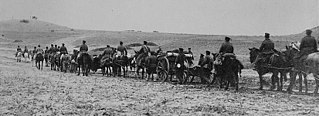
In military contexts, a train is the logistical transport elements accompanying a military force. Often called a supply train or baggage train, it has the job of providing materiel for their associated combat forces when in the field. When focused on provision of field artillery and its ammunition, it may be termed an artillery train. For sieges, the addition of siege engines to an artillery train was called a siege train. These military terms predate, and do not imply a railway train, though railways are often employed for modern logistics, and can include armoured trains.

Backpacking with animals is the use of pack animals, such as a horse, llama, goat, dog, or donkey to help carry the weight of a backpackers gear during an excursion. These animals need special considerations when accompanying backpackers on a trip. Some areas restrict the use of horses and other pack animals. For example, Great Basin National Park does not allow domestic animals at all in backcountry areas.
Animal welfare and rights in Ethiopia is about the treatment of and laws concerning non-human animals in Ethiopia. Ethiopia has highly limited animal welfare regulations by international standards, and appears to have little animal activism.
Farm Animal refers to livestock.

